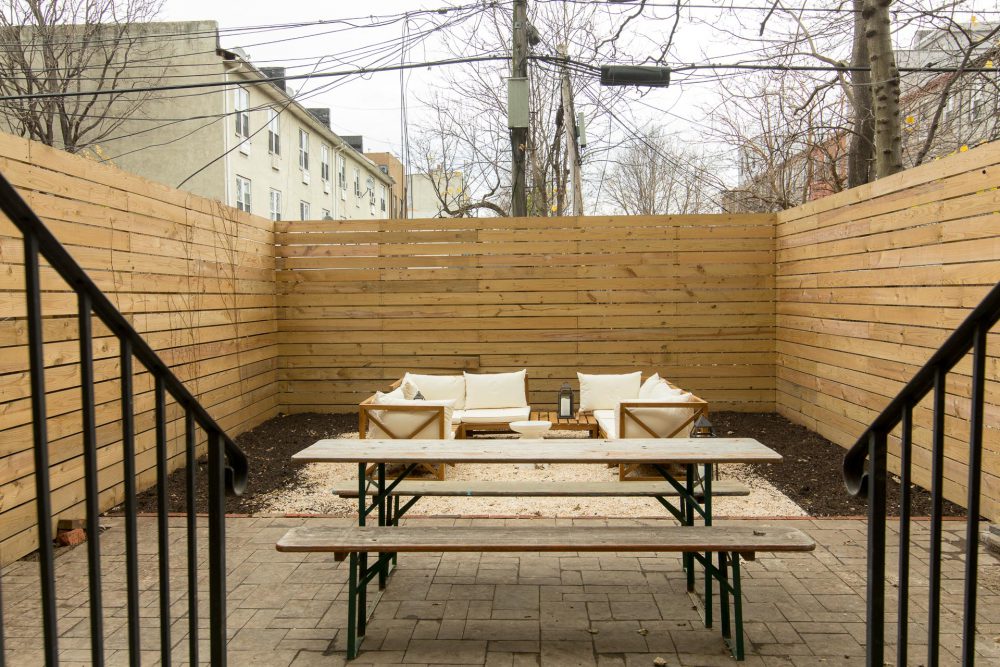Roommates Forever: Collective Housing on the Market
Emily Nonko looks at a few distinct housing models that are pushing collective living to the forefront.

A communal dining area in WeLive’s location in the Crystal City neighborhood of Arlington, Virginia.
Editor's Note
Many artists and activists working in New Orleans use their practices to address ongoing issues of fair housing, equitable development, and cultural ownership in the city. To add to the conversation, we asked journalist Emily Nonko to take a look at a few collective housing initiatives in New York that are spreading to other cities.
This spring, U.S. Census data revealed that the Big Apple had gotten as big as it’s ever been: The population surpassed 8.5 million people for the first time in the city’s history. The arrival of new New Yorkers, in fact, has long been on the upswing and has increased 4.6 percent in just the past five years. Population booms aren’t only playing out in New York, either. The same Census data revealed that on the West Coast, the Bay Area’s population grew by more than 90,000 people in one year. The population of New Orleans has continued its steady growth since the years immediately following Hurricane Katrina. And for the seventh time in eight years, Denver led the state of Colorado in population growth.
In short: People want to be in cities. There is an assumption that all those people happen to be millennials. While young people have flocked to cities in high numbers—this study found that 23 out of 25 of the country’s largest cities are seeing growth in the population of college-educated adults under the age of 45—dense, walkable metropolises are also attracting baby boomers that have started retiring in droves. And for many, young and old, there’s a particular appeal of trying to make it in New York, especially as crime has decreased, tourist attractions have opened, and places like Brooklyn have gained cultural cachet. But with all the new arrivals—and the gentrification and rent hikes that come with them—the city has had to ask itself the very pressing question of where, exactly, everyone is going to live.
The time is ripe, it seems, for housing innovations, and some companies and organizations in New York are already thinking outside of the box. The New York Foundation for Senior Citizens (NYFSC), a non-profit, has run its home sharing program since 1981, but the initiative has seen a recent surge of media attention as affordable housing has diminished in the city. And new programs, like WeLive and Common, have emerged to offer New Yorkers, many of them millennials, additional models for living together. While each program is different, they address similar housing issues facing residents: hesitations toward Craigslist room shares, the necessity of a financially stable place to live as neighborhoods get more expensive, and the desire for a supportive community base to come home to.
Millennials, typically in their first job out of college, and seniors, typically living on a fixed income, are two of the many groups struggling to find decent housing in the city. “The cost of housing in New York has driven up astronomically, to the point that decent salaries are not adequate,” explains Susan Saegert, a professor at the Graduate Center of the City University of New York who studies alternative housing. “Sharing is required with millennials and seniors as an economic means.” Because New York’s apartment inventory offers more large apartments than studios, roommate shares are the most typical solution to cutting housing costs.
For seniors, “a top priority…has always been affordable housing,” says Linda Hoffman, president of NYFSC. That was the case when the Foundation started its home sharing program in 1981, and it’s still the case today. “The idea is to help seniors and non-seniors remain in their own homes and community, as the cost of maintaining homes increases and we have more seniors on fixed incomes,” she said. The free program matches “hosts” who have a private bedroom available within their apartment or house with “guests” who pay rent. Either the host or guest must be at least 60 years old, but the program has attracted people of all ages. The program also serves hosts, age 55 or over, who want to share their homes with a developmentally disabled guest.
The NYFSC provides matchmaking between hosts and guests using social work techniques, and if things don’t work out, hosts must give guests a 30-day notice. But for many, it works. Hoffman recalls a woman in the Bronx who serves as “house mother” to guests with disabilities. Her guests help her pay her mortgage, but they’ve also formed a bond. “They play checkers together,” Hoffman says. “With home share, the home becomes the community.”
Some hosts need help paying rent or their mortgage; others don’t like being alone at night and want the feeling of security a roommate brings. Some seniors are actively trying to stay in their communities as prices get higher. (Earlier this summer, city officials came to Bedford-Stuyvesant, a rapidly gentrifying neighborhood of Brooklyn, to explain how the home sharing program worked.) And many seniors are living out their dreams of moving to New York but don’t feel comfortable searching for an affordable share on Craigslist. Other guests are young people moving to the city for the first time, and are students, actors, dancers, artists, those in career transitions. (There’s a poster up at the Actors Fund headquarters promoting the home-share program.) “It’s everybody,” as Hoffman puts it. NYFSC gets about 2000 calls and makes about 80 matches every year. “If there is the demand,” Hoffman said, “We will meet it.”

The backyard of Common’s location on Albany Avenue in Crown Heights, Brooklyn.
When the program first launched, “people were petrified of living with strangers,” Hoffman says. She adds that “slowly but surely we gained a track record of confidence with the public.” When the Internet emerged, things really changed, and the Foundation got attention from people around the world looking to come to New York. It’s that sharing economy, fostered by the Internet and tech scene, that’s led to another innovative roommate program known as “co-living.” Two companies—Common and the office-sharing empire WeWork—both launched co-living programs in New York this year. The ideas there, according to Danny Robin, the community director at Common, are “valuing experiences over things, owning less, and sharing more.”
WeWork opened its co-living building, WeLive, in Manhattan’s Financial District this spring. Common launched its first building in Crown Heights, Brooklyn, late last year and has opened two more, in Crown Heights and Williamsburg, in 2016. Each company has its own distinct culture, but the business idea is the same: Offer furnished, flexible rentals to individuals alongside shared community space, programming, and benefits like weekly cleaning services and unlimited supplies of toilet paper.
“The biggest issue in cities right now is availability,” explains Quinton Kerns, a designer with WeLive. “Studio apartments only account for two to five percent of the housing stock in cities, but the majority of households in major cities are now single.” WeLive seeks to accommodate those single New Yorkers while also providing a community base that’s reminiscent of a college dorm. The 27-story, 196-unit building is divided into separate “communities” every three floors; community managers organize resident activities that include yoga, Ping-Pong matches, and family dinners.
Over at Common, Robin has tapped into a sentiment that seems to be growing among young people across the country: “This is not our parents’ generation…we are staying in high-density, urban environments,” she said. “We are rejecting the suburbs, but when we move to cities, we lose community. There’s a desire to share and collaborate more.” She says that Common aims to provide not just community but also convenience. The buildings aim to eliminate the hassles of city living, such as shady brokers, unresponsive landlords, sticking a rent check under a roommate’s door. (Pretty much everything, from paying rent to reporting something broken, is done online.)
One sticking point of these co-living programs: They aren’t exactly solving the problem of affordable housing. “It’s a market solution to a market-driven problem,” as Saegert puts it. When Common first launched last year, rents ranged from $1800 to $1950 for a private bedroom and access to shared common areas. At WeLive, beds in one- to four-bedroom apartments rent at $1375 a month, while private rooms start at $2000 a month. But advocates argue that the rent gets you more bang for your buck. In a traditional apartment, Robin says, “there’s the base rent, Wi-Fi, the cleaners, utilities; you spend so much time and money furnishing the apartment.” She thinks that Common’s rent, which they call a membership, is “absolutely equivalent [to a traditional apartment] if not way smarter…but we needed to do a lot of education around that.”
Even if there’s some sticker shock, people are biting at the idea of co-living. Common is expanding to San Francisco and Washington, D.C., while WeLive, already in D.C., is considering new cities for expansion. “The trend as a whole is taking hold,” said Kerns. Something that’s particularly surprised him at WeLive, he said, is how the sharing component hasn’t just appealed to millennials but “attracts people from all walks of life, including families and seniors.” It’s a housing solution that will likely work as long as Kern’s observation remains true: “We’ve come back to cities, we aren’t living in the suburbs...People won’t stop moving to New York.”



